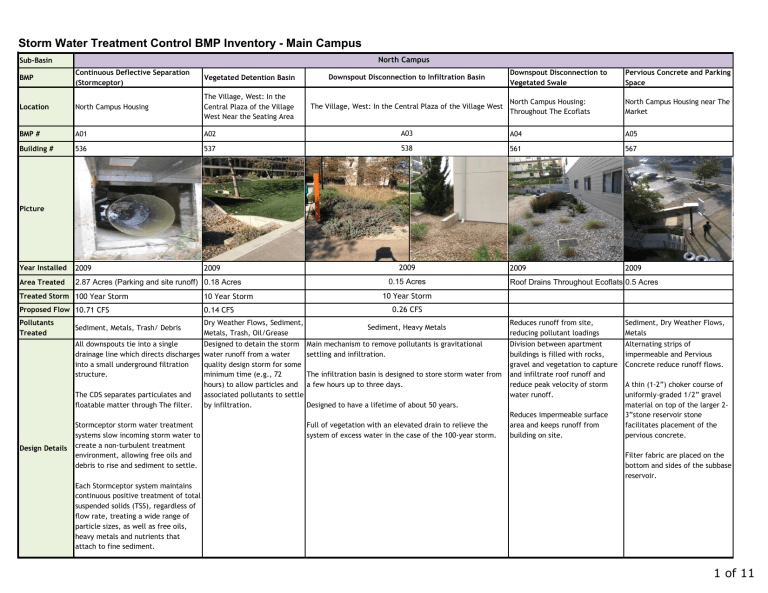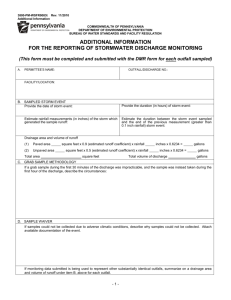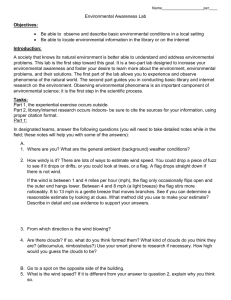Storm Water Treatment Control BMP Inventory - Main Campus North Campus
advertisement

Storm Water Treatment Control BMP Inventory - Main Campus North Campus Sub-Basin BMP Continuous Deflective Separation (Stormceptor) Vegetated Detention Basin Downspout Disconnection to Infiltration Basin Location North Campus Housing The Village, West: In the Central Plaza of the Village West Near the Seating Area The Village, West: In the Central Plaza of the Village West BMP # A01 A02 536 Year Installed 2009 Area Treated 2.87 Acres (Parking and site runoff) 0.18 Acres Building # Downspout Disconnection to Vegetated Swale Pervious Concrete and Parking Space North Campus Housing: Throughout The Ecoflats North Campus Housing near The Market A03 A04 A05 537 538 561 567 2009 2009 2009 2009 Picture Treated Storm 100 Year Storm 10 Year Storm Proposed Flow 10.71 CFS 0.14 CFS Pollutants Treated Dry Weather Flows, Sediment, Metals, Trash, Oil/Grease Sediment, Metals, Trash/ Debris All downspouts tie into a single drainage line which directs discharges into a small underground filtration structure. The CDS separates particulates and floatable matter through The filter. Design Details Stormceptor storm water treatment systems slow incoming storm water to create a non-turbulent treatment environment, allowing free oils and debris to rise and sediment to settle. Designed to detain the storm water runoff from a water quality design storm for some minimum time (e.g., 72 hours) to allow particles and associated pollutants to settle by infiltration. 0.15 Acres Roof Drains Throughout Ecoflats 0.5 Acres 10 Year Storm 0.26 CFS Sediment, Heavy Metals Main mechanism to remove pollutants is gravitational settling and infiltration. The infiltration basin is designed to store storm water from a few hours up to three days. Reduces runoff from site, reducing pollutant loadings Sediment, Dry Weather Flows, Metals Division between apartment buildings is filled with rocks, gravel and vegetation to capture and infiltrate roof runoff and reduce peak velocity of storm water runoff. Alternating strips of impermeable and Pervious Concrete reduce runoff flows. Designed to have a lifetime of about 50 years. Full of vegetation with an elevated drain to relieve the system of excess water in the case of the 100-year storm. Reduces impermeable surface area and keeps runoff from building on site. A thin (1-2”) choker course of uniformly-graded 1/2” gravel material on top of the larger 23”stone reservoir stone facilitates placement of the pervious concrete. Filter fabric are placed on the bottom and sides of the subbase reservoir. Each Stormceptor system maintains continuous positive treatment of total suspended solids (TSS), regardless of flow rate, treating a wide range of particle sizes, as well as free oils, heavy metals and nutrients that attach to fine sediment. 1 of 11 Storm Water Treatment Control BMP Inventory - Main Campus North Campus Sub-Basin Rock Swale Downspout Disconnection to Vegetated Swale Parking for North Campus Housing Parking for Rady School of Rady School of Management (North of Rady School of Management Management (North or Rady School of (Northwest tip of the Rady School of and West of Parking Lot) Management, small parking lot) Management) Rady School of Management (Northwest tip of the Rady School of Management) Central Plaza in Rady School of Management BMP # A06 A07 A08 A09 A10 Building # P357 P351 581 581 581 Year Installed 2009 2012 2012 2012 2012 Area Treated 2.9 Acres 0.24 Acres 1.33 Acres 0.12 Acres 0.75 Acres Treated Storm 2 Year Storm 10 Year Storm 85th percentile (.2in/hr) 10 Year Storm 10 Year Storm Proposed Flow 6.0 CFS 0.80 CFS 0.27 CFS 0.31 CFS 2.25 CFS Pollutants Treated Sediment, Oil, Dry Weather Flows, Metals Sediment, Oil, Dry Weather Flows, Metals Sediment, Dry Weather Flows, Metals Sediment, Dry Weather Flows, Metals Runoff channels from Parking lot P357 lead through a pretreatment rocky path until it collects in a detention basin. Runoff from parking lot P351 flows Depression in the rain gutter channels into rocky swale through opening in a water into catch basin. cut curb. The vault type BMP holds water and Uses natural filtering ability of the makes it available to grass plants soil and plants to remove pollutants rooted above. from storm water runoff through infiltration. Excess water in the event of a higher flow than proposed runs off into Rocks help slow peak velocities which storm drain. maximizes pollutant removal effectiveness by increasing residence time of water in swale. BMP Rock Detention Basin Location Cut Curb Into Vegetated Swale Modular Wetland Picture Uses natural filtering ability of the soil and plants to remove pollutants in storm water runoff by infiltration. Design Details Basin is sized to infiltrate water volume within 72 hours. In case of 100-year storm, there is a drain that is elevated to prevent water from over flowing. Reduces runoff from site, reducing pollutant loadings Located underneath the West point of An alternative to using piped the Rady Building. channels to expel storm water, several of the buildings downspouts Combines rocky trails and dry dispose of roof runoff into rocky and vegetation to create a treatment vegetated channels. train to settle and reduce storm water velocity by infiltration. Vegetation and rocks help infiltrate water into the soil, slow peak velocity, and reduce runoff volume from site. Storm drain located 5 meters from cut curb, collecting cleaner storm water. 2 of 11 Storm Water Treatment Control BMP Inventory - Main Campus North Campus Sub-Basin BMP Location Vegetated Swale Building # Thurgood Marshall Downspout Disconnection to Rock Swale Vegetated Detention Basin San Diego Supercomputer Office Addition Hopkins Parking Garage Goodies Market A11 A14 A12 A13 South of 581 480 495 375 Rock Swale The Wedge Phase IIIand IV: South of Rady School of Management Building BMP # Eleanor Roosevelt Downspout to Vegetated Detention Basin Picture Year Installed Phase III (2008) Phase IV (2010) Area Treated 1.26 Acres 1.98 Acres Treated Storm 85th percentile (0.54 in/hr) 85th percentile (0.54 in/hr) Proposed Flow 0.401 CFS 0.739 CFS Pollutants Treated Dry Weather Flows, Sediment, Metals, Trash/ Debris Dry Weather Flows, Sediment, Metals, Trash/ Debris Area South of Rady Management Building is filled with rocks, gravel and vegetation to help slow peak velocity of storm water. Slows down water to allow for sedimentation and infiltration before it reaches drain at the base of the slope. Design Details 2007 Roof of building Roof of parking garage Sidewalk runoff Reduces runoff from site, reducing pollutant loadings Reduces runoff from site, reducing pollutant loadings Dry Weather Flows, Sediment, Metals, Trash/ Debris Runoff from building 480 roof drains into basin. Each floor of Hopkins garage drains into this side cobble swale. Area across from Goodies Market is filled with rocks, gravel and vegetation to help slow peak velocity of storm water. Vegetation and cobbles help infiltrate The large cobbles help slow the water into soil. water velocity, and allow water to infiltrate reducing the volume of Reduces impermeable surface area or region, keeps runoff from building on Excess water in the case of a large runoff from the site. site. storm is overflown to a large cobble field as part of a treatment train. Drain at the bottom of slope is A large treatment train that contains gravel, coble and vegetation to reduce surrounded by large cobbles as well. storm water velocities. Allows for sedimentation through infiltration. Reduces impermeable surface area or region, keeps runoff from building on site. Gravel channel meanders across the slope, reducing the effects of erosion. 3 of 11 Storm Water Treatment Control BMP Inventory - Main Campus Muir Sub-Basin BMP Downspout Disconnection to Vegetated Detention Basin Location Tamarack Apartments BMP # B01 240-241 Building # Mesa Housing Downspout to Detention Basin Infiltration Basin Downspout Disconnection into Vegetated Swale Mesa Housing Near Building 3 East Campus- One Miramar East Campus Throughout Graduate Housing- One Miramar B06 E10 E11 E12 270 3635 3635 3635 Roof of building Parking lot runoff Roof of building Reduces runoff from site, reducing pollutant loadings Sediment, Metals, Trash, Oil/ Grease, Dry Weather Flows Reduces runoff from site, reducing pollutant loadings Roof runoff is channeled into landscape where there is a depression in the center. Uses natural filtering ability of Storm water from the roof of all the soil to remove pollutants in of the East Campus Graduate storm water runoff. Housing Buildings drains into a Vegetated Swale, where rocks and Vegetation helps reduce peak plants infiltrate water into the storm water velocities. soil, slow peak velocity, and reduce runoff volume from site. Basin is sized so water volume can be infiltrated within 48 hours. Loading Dock Run-off to Vegetated Swale Faculty Club Picture Year Installed 2011 Area Treated Roof of building Loading dock and trash storage area Treated Storm Proposed Flow Pollutants Treated Reduces runoff from site, reducing pollutant loadings Dry Weather Flows, Sediment, Metals, Trash/ Debris, Oil Attributing to Tamaracks LEED Gold Runoff from Faculty Club loading dock and trash storage area certification is its ability to flows into a vegetated swale through opening/pipe in a cut curb. infiltrate all of the storm water on site. Uses natural filtering ability of the soil and plants to remove pollutants from storm water runoff through infiltration. Detention basins are located around building with cobbles and Rocks help slow peak velocities which maximizes pollutant vegetation. removal effectiveness by increasing residence time of water. Design Details Roof runoff drains into basins, where the water infiltrates into the soil, reducing storm water runoff from the site. Vegetation and cobbles help settle the water and allow for water to be infiltrated in soil within 72 hours. 4 of 11 Storm Water Treatment Control BMP Inventory - Main Campus Revelle Sub-Basin BMP Location Downspout Disconnection to Vegetated Swale Housing and Dining Admin Building South Side Vegetated Roof Revelle Housing (Keeling Apartments) Downspout Disconnections into Vegetated Detention Basin Revelle Housing (Central Plaza of Keeling Apartments) BMP # B02 B03 B04 Building # 129 189 189 Year Installed 2010 2011 2012 Area Treated 0.47 Acres Treated Storm 85th percentile (0.53 in/hr) Proposed Flow 0.313 CFS Picture Pollutants Treated Reduces runoff from site, reducing pollutant loadings Reduces runoff from site, reducing pollutant loadings 0.82 Acres 100 Year Storm 85th percentile (0.53 in/hr) 0.60 CFS 0.61 CFS Sediment, Metals, Bacteria Vegetation and cobbles help infiltrate water into the soil, slow peak velocity, and reduce runoff volume from site. Design Details 0.82 Acres Vegetation and cobbles help infiltrate Uses light-weight soil mixes to reduce water into the soil, slow peak loads. velocity, and reduce runoff volume from site. Contains several layers of protective materials to convey water away from Pollutant removal effectiveness can the roof deck. These generally be maximized by increasing residence include (from the bottom up) a time of water in swale using waterproof membrane, a root barrier, vegetation and gravel. a layer of insulation, a drainage layer, a filter fabric for fine soils, the engineered growing medium or soil substrate, and the plant material. Sedums and succulents, a common vegetated roof plant, have fleshy water-storing leaves that do not burn easily, even in near drought conditions. Excess water flows is passed to detention basin. Reduces runoff from site, reducing pollutant loadings Reduces runoff from site, reducing pollutant loadings Attributes to Revelle Apartments LEED Platinum certification (the highest award for efficiency and sustainability). Attributes to Revelle Apartments LEED Platinum certification (the highest award for efficiency and sustainability). Runoff from building 189 roof drains into basin. Runoff from building 189 roof drains into basin. Vegetation and cobbles help infiltrate Vegetation and cobbles help infiltrate water into soil. water into soil. Excess water in the case of a large storm is overflown to a large cobble field as part of a treatment train. Excess water in the case of a large storm is overflown to a large cobble field as part of a treatment train. 5 of 11 Storm Water Treatment Control BMP Inventory - Main Campus Sub-Basin BMP Location BMP # Building # Revelle School of Medicine Vegetated Roof Filterra Unit (Tree box) CONTECH Storm Water Solutions Rock Swale Atkinson Graduate Student Housing Atkinson Graduate Student Housing Atkinson Graduate Student Housing Atkinson Graduate Student Housing B05 C03 C04 C05 C06 P104 and 188-189 881 881 881 881 2012 2012 2012 2012 Roof of building Parking lot and building runoff Reduces runoff from site, reducing pollutant loadings Sediment, Metals, Dry Weather Dry Weather Flows, Sediment, Sediment, Metals, Trash/ Debris Flows Metals, Trash/ Debris Rock Swale Revelle Parking Lot, and Revelle Housing (Keeling Apartments) Picture Year Installed 2012 Area Treated Parking lot, bulding, and basketball court runoff Treated Storm 85th percentile (0.53 in/hr) Proposed Flow 2.13 CFS Pollutants Treated Dry Weather Flows, Sediment, Metals, Trash/Debris Part of treatment train for all the storm water that hits the Revelle All downspouts lead to apartments and parking lot P104. vegetated landscape surrounding the parameter of The varying sizes and assortment of cobbles and vegetation add the building. aesthetic value while maximizing pollutant removal effectiveness by increasing water residence time in swale. Rocks help slow rain velocities and allow sedimentation of pollutants. Design Details Beginning of Treatment train for the water from parking lot. Large cobbles help remove large sediment and debris. Water is then directed to large rock swale. Contributing toward the buildings LEED Silver rating. CDS unit uses an indirect screening technique to treat storm water runoff and capture Filterra Bioretention Systems suspended solids, fine sands and are design to remove pollutants larger particles. and total suspended solids. Also captures and retains trash, Runoff is directed into throat debris and 70% of oil/ grease in opening, which is then treated runoff water using oil baffles. by passing through specialized filter media and vegetation roots before it is discharged through small under drain. Parking lot runoff Area behind Atkinson Graduate Housing has a treatment train filled with rocks and vegetation to help slow peak velocity of storm water. Allows for sedimentation through infiltration. Reduces impermeable surface area or region, keeps runoff from building on site. Requires little space and is very effective. 6 of 11 Storm Water Treatment Control BMP Inventory - Main Campus School of Medicine Sub-Basin University Center BMP Downspout Disconnection Rock Swale Downspout Disconnection to Rock Swale Stormceptor and Retention Tank Stromceptor Location Biomedical Research Facility II Biomedical Research Facility II Medical Education and Telemedicine Building Biomedical Research Facility II BMP # C07 C09 C10 C11 C08 P405 Building # Between 873-875 875 845 875 Year Installed 2014 2014 2011 2014 Area Treated Roof and sidewalk runoff Roof of building Roof and sidewalk runoff Street and parking runoff Dry Weather Flows, Sediment, Metals, Trash/ Debris Reduces runoff from site, reducing pollutant loadings Area along the side of the building is filled with rocks to help capture runoff, infiltrate water into the soil, slow peak velocity, and reduce runoff volume from site. Roof drains from Biomedical Research Facility II discharge into a treatment train filled with rocks and vegetation to help slow peak velocity of storm water. Parking Lot Runoff to Vegetated Swale Parking Lot P405 Picture Parking lot runoff Treated Storm Proposed Flow Pollutants Treated Allows for sedimentation through infiltration. Design Details Reduces impermeable surface area or region, keeps runoff from building on site. Sediment, Oil, Dry Weather Flows, Metals, Trash/Debris Stormceptor storm water treatment systems slow incoming storm water to create a non-turbulent treatment environment, allowing free oils and debris to rise and sediment to settle. Stormceptor storm water treatment systems slow incoming storm water to create a non-turbulent treatment environment, allowing free oils and debris to rise and sediment to settle. Each Stormceptor system maintains continuous positive treatment of total suspended solids (TSS), regardless of flow rate, treating a wide range of particle sizes, as well as free oils, heavy metals and nutrients that attach to fine sediment. Each Stormceptor system maintains continuous positive treatment of total suspended solids (TSS), regardless of flow rate, treating a wide range of particle sizes, as well as free oils, heavy metals and nutrients that attach to fine sediment. Runoff from parking lot P405 flows into rocky swale through opening in a cut curb. Uses natural filtering ability of the soil and plants to remove pollutants from storm water runoff through infiltration. Rocks help slow peak velocities which maximizes pollutant removal effectiveness by increasing residence time of water. Retention tank is underground and meant to slow the peak velocity of runoff. 7 of 11 Storm Water Treatment Control BMP Inventory - Main Campus University Center Sub-Basin Structural and Materials Engineering Building Rock Swale Pervious Concrete For Electric Infiltration Basin Vehicle Parking Downspout Disconnection to Vegetated Swale Structural and Materials Engineering Structural and Materials Engineering Structural and Materials Engineering All Around Building BMP Pervious Concrete Location University Center-Student Services BMP # C01 C02 D01 D02 D03 931 955 734 734 734 Building # Prebys Music Center Picture 2012 2012 2012 2012 2012 1.9 Acres 1.9 Acres Parking area Building runoff Roof of building Treated Storm 10 Year Storm 10 Year Storm Proposed Flow 2591 Cubic Ft 2591 Cubic Ft Reduces runoff from site, reducing pollutant loadings Coarse to Fine Sediments and attached pollutants Reduces runoff from site, reducing pollutant loadings A thin (1-2”) choker course of uniformly-graded 1/2” gravel material on top of the larger 23”stone reservoir stone facilitates placement of the pervious concrete. Designed to temporarily hold storm water runoff for up to 72 hours before infiltrating into soil. Vegetation and rocks/gravel help capture roof runoff, infiltrate water into the soil, slow peak velocity, and reduce runoff volume from site. Year Installed Area Treated Pollutants Treated Design Details Roof and building runoff Sediment, Metals, Dry Weather Flows Dry Weather Flows, Sediment, Metals, Trash/ Debris A thin (1-2”) choker course of uniformly-graded 1/2” gravel material on top of the larger 23”stone reservoir stone facilitates placement of the pervious concrete. Area around the music center is filled with rocks, gravel and vegetation to help slow peak velocity of storm water. Base of open-graded crushed aggregate with no fine sands. Must be designed to support surface uses, allow water to flow through, and prevent migration of subbase soils. Pollutant removal effectiveness is maximized by being stored and settled in 72” underground pipe. Base of open-graded crushed aggregate with no fine sands. Reduces impermeable surface area or region, keeps runoff from Must be designed to support building on site. surface uses, allow water to flow through, and prevent migration of subbase soils. Filter fabric are placed on the bottom and sides of the subbase reservoir. In areas with low permeability soil, an under-drain system may be needed. Allows for sedimentation through infiltration and adds aesthetic value. Infiltration through the sub-soils serves to remove sediments and Pollutant removal effectiveness attached pollutants. can be maximized by increasing residence time of water in Designed to reduce runoff swale using vegetation and volumes, and reduce gravel. downstream peak flows by infiltrating all storm water on site. Filter fabric are placed on the bottom and sides of the subbase reservoir. In areas with low permeability soil, an under-drain system may be needed. 8 of 11 Storm Water Treatment Control BMP Inventory - Main Campus East Campus Medical Center Sub-Basin BMP Infiltration Basin and Rock Swale* Filterra Unit (6)* Infiltration Basin* Vegetated Detention Basin* Downspout Disconnection into Vegetated Swale* Location Parking Structure 9450 on South West Side of the Parking Structure East Campus Office Buildings East Campus Office Buildings East Campus Office Buildings East Campus Office Building (Downspouts Exist Around the Entire Building) BMP # E01/E02 E03 E04 E05 E06 Building # 9450 9444 9444 9444 9445 Year Installed 2011 2012 2012 2012 2012 Area Treated 4.97 Acres 1.59 Acres 1.01 Acres 0.69 Acres Roof of building Treated Storm 2 Year Storm 85th Percentile 10 Year Storm Proposed Flow 11,739 Cubic Ft 3,769 Cubic Ft 3,769 Cubic Ft Picture Pollutants Treated Design Details Sediment, Metals, Trash, Oil/ Grease, Dry Weather Flows Sediment, Metals, Trash, Oil/ Grease, Dry Weather Flows Large series of connected rock swales and basins channel all water from parking structure and soccer field and infiltrates water into soil on site. Filterra Bioretention Systems are design to remove pollutants and total suspended solids. Sediment, Metals, Trash, Oil/ Grease, Dry Weather Flows Sediment, Dry Weather Flows Reduces runoff from site, reducing pollutant loadings Water is diverted from street into Runoff entering the system is stored filterra units, then under drains lead in a series of connected pipes. to this cobble detention basin. Removes sediments and attached Runoff is directed into throat Uses natural filtering ability of the pollutants by settling the water. opening, which is then treated by soil and plants to remove pollutants Uses natural filtering ability of the passing through specialized filter in storm water runoff. Reduces runoff volumes, delaying soil and plants to remove pollutants media and vegetation roots before it runoff peaks by providing detention in storm water runoff by infiltration. is discharged through small under Basin is sized to infiltrate water storage. drain volume within 72 hours. Detains water for a maximum of 72 hours after storm for mosquito Requires little space and is very In case of a storm of very high prevention. effective. volume, there is a drain that is elevated to prevent water from over In case of 100-year storm, there is a flowing. drain that is elevated to prevent water from over flowing. Storm water from the roof of the East Campus Office Building drains into a Vegetated Swale, where rocks and plants help infiltrate water into the soil, slow peak velocity, and reduce runoff volume from site. *property leased to external organization *property leased to external organization *property leased to external organization *property leased to external organization *property leased to external organization Reduces quantity of storm water runoff during peak flows. 9 of 11 Storm Water Treatment Control BMP Inventory - Main Campus East Campus Medical Center Sub-Basin East Campus North Torrey Pines Glider Port Science Research Park BMP Stormceptor* Vegetated Swale* Cut Curb into Infiltration Basin Vegetated Detention Basin* Rock Swale Infiltration Basin* Location East Campus- Medical Center Drive North East Campus Office Building Parking Lot East Campus- Parking Lot 705 (Northwest Corner of the Parking Lot) East Campus- Science Research Torrey Pines Center North on Park the North Side of the Building Sanford Consortium for Regenerative Medicine, South Side of the Building BMP # E07 E08 E13 E09 TP1 TP2 Building # P752 P759 P705 Outside of P783 505 501 2005 2012 Runoff from SRP Roof and sidewalk runoff Roof and sidewalk runoff Sediment, Metals, Trash, Oil/ Grease, Dry Weather Flows Sediment, Metals, Trash, Oil/ Grease, Dry Weather Flows Reduces runoff from site, reducing pollutant loadings Reduces runoff from site, reducing pollutant loadings Uses natural filtering ability of Water is diverted from parking the soil to remove pollutants in lot 705 through a cut curb into storm water runoff. an infiltration basin. Transformed a natural canyon into a large detention basin. Area along the side of the building is filled with rocks, gravel and vegetation to help slow peak velocity of storm water. Main mechanism to remove pollutants is gravitational settling and infiltration. Picture Year Installed Area Treated Parking lot 2005 Parking lot runoff Treated Storm Proposed Flow Pollutants Treated Stormceptor storm water treatment systems slow incoming storm water to create a non-turbulent treatment environment, allowing free oils and debris to rise and sediment to settle. Design Details Basin is sized so water volume can be infiltrated within 48 hours. Each Stormceptor system maintains continuous positive treatment of total suspended solids (TSS), regardless of flow rate, treating a wide range of particle sizes, as well as free oils, heavy metals and nutrients that attach to fine sediment. *property leased to external organization Main mechanism to remove pollutants is gravitational settling and infiltration. Detention Basin is design to store and hold large quantities of storm water, utilizing the natural filtering ability of the soil to remove pollutants. This large basin is design to infiltrate water volume within 72 hours. Allows for sedimentation through infiltration. Designed to reduce runoff volumes, and reduce downstream peak flows by infiltrating storm water on site. Reduces impermeable surface area or region, keeps runoff from building on site. Elevated storm drain in the case of the very high flows so the BMP does not fail. *property leased to external organization *property leased to external organization *property leased to external organization 10 of 11 Storm Water Treatment Control BMP Inventory - Main Campus North Torrey Pines Glider Port Sub-Basin Unit Paver Fire Lane* Campus Services Complex BMP Infiltration Basin* Cut Curb into Vegetated Swale* Storm Drain Inlet Treatment System Location Corner of Torrey Pines Scenic Dr. and Sanford Consortium for Regenerative Sanford Consortium for Regenerative North Torrey Pines Road, Just South CSC parking lot 507 Medicine, West Side of Building Medicine, West Side of the Building of Torrey Pines Center South BMP # TP3 TP4 TP5 D04 Building # 501 501 P384 West Side of P507 Picture 2013 Year Installed Area Treated Roof and sidewalk runoff Hardscape runoff Parking Lot Area Reduces runoff from site, reducing pollutant loadings Sediment, Metals, Trash, Oil/ Grease, Sediment, Oil, Dry Weather Flows, Dry Weather Flows Metals, Trash/Debris Parking Lot Area Treated Storm Proposed Flow Pollutants Treated Main mechanism to remove pollutants Porous turf surface can be used for is gravitational settling and temporary parking (fire lane parking). infiltration. Pollutants collected from building runoff, and temporary parking are Designed to reduce runoff volumes, treated by settling through and reduce downstream peak flows infiltration. by infiltrating storm water on site. Main mechanism to remove pollutants is gravitational settling and infiltration. Design Details Designed to reduce runoff volumes, and reduce downstream peak flows by infiltrating storm water on site. *property leased to external organization *property leased to external organization Dry Weather Flows, Oil & Grease, Gasoline, Diesel, PAHs, Trash, Sediments, Foliage, Debris Runoff from parking lot P384 flows Storm Drain Inlet Treatment System Collects debris into rocky swale through opening in a and sediment in catch basin before it can enter the cut curb. storm drain system. Uses natural filtering ability of the soil and plants to remove pollutants from storm water runoff through infiltration. Also functions to filter out smaller pollutants by filtering runoff water through a BioSorb Hydrocarbon Boom (media filled sock) before it can be discharged into the ocean. Rocks help slow peak velocities which maximizes pollutant removal effectiveness by increasing residence time of water. *property leased to external organization 11 of 11







